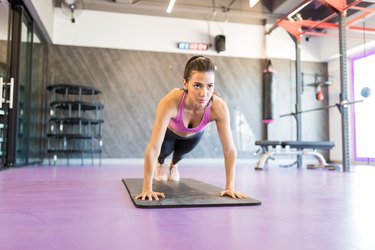
Calisthenic training involves any exercises performed using no added weight, and is commonly referred to as body-weight training. This type of training can be done as a stand-alone routine or programmed into any weight loss, bodybuilding or fitness workout. Calisthenics benefits include convenience and the fact that it can be tailored to suit beginner, intermediate or advanced trainees.
Tip
Calisthenic training is a way of working out with only your body weight. These exercises can be done anywhere and include moves such as push-ups, squats and burpees.
Video of the Day
Upper-Body Calisthenic Exercises
The most well-known upper-body calisthenic exercises are push-ups and pull-ups. Push-ups are great for building muscle in your chest, shoulders and triceps muscles, as well as improving your core stability and muscular endurance. Pull-ups work your back, biceps and grip, and are a great test of upper-body strength.
Video of the Day
You don't have to stick to regular versions of the exercises, though. For push-ups, you can try knee push-ups, doing them on a stability ball or medicine ball, or even doing them with just one arm. For pull-ups, try changing your grip width, or use a tree branch or pair of gymnastic rings for an extra challenge.
Read more: Five Types of Fitness Training
Lower-Body Calisthenic Exercises
One of the most effective lower-body calisthenics is the squat. Stand with your feet slightly wider than shoulder-width apart, and your toes turned out about 10 degrees. Squat down by pushing your hips back and knees out, until you can go no lower, then stand back up again.
You can perform different variations of the squat to get a whole lower-body workout. Change your foot placement and speed, or try Tabata squats, where you perform as many repetitions as you can in 20 seconds, rest for 10 seconds, then repeat for another seven rounds. One-legged squats, known as pistols, are a challenging variation that can increase your lower-body strength, balance and mobility.
Lunges, in which you take a large step forward, and then lower your body until your front leg is parallel to the floor, are another effective body-weight calisthenics. This exercise targets your quads but uses a number of other muscles.
How to Plan Calisthenic Training
If you're looking to lose weight or increase your fitness, then you can rely solely on calisthenic training to get you great results. Plan four sessions per week — two focusing on upper-body exercises and two focusing on the lower body.
As well as the exercises listed above, you can add in others, such as burpees, mountain climbers, planks, crunches, inverted rows and lunges. If, however, you're training for muscle size and strength, then calisthenic training should be done alongside your weights workouts. After three of your weights sessions every week, set up a full-body body-weight exercise circuit, containing four or five exercises, and complete as many rounds as you can in 15 minutes.
Read more: Ways to Get Buff at Home Without Weights
Calisthenics Benefits and Considerations
The main benefit of calisthenic training is that it can be done anywhere, and you require minimal equipment to do it. The U.S. Army recommends calisthenic training to its recruits, saying that it helps to build muscular strength and endurance, as well as improving bone and joint strength, which aids in preventing injuries. If you're a beginner, then this method of training is also perfect to help you develop a basic level of coordination, stability and muscular control, before moving on to weighted exercises.